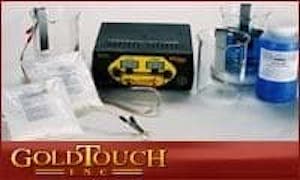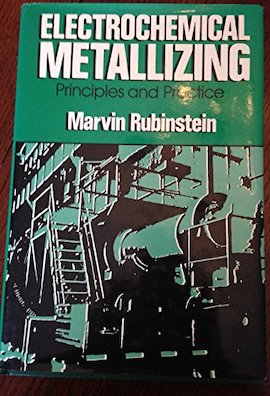
Curated with aloha by
Ted Mooney, P.E. RET

The authoritative public forum
for Metal Finishing 1989-2025

-----
Brush plating SS with Wood's Nickel
adv.
Brush plating equipment, chemicals, and supplies from Gold Touch

Q. I read that before plating stainless steel I should activate it first with Wood's nickel (240 g/l NiCl2, 120 Hcl ml/l) but doing it by brush made severe burns all over the stainless steel surface; I diluted the Wood's nickel bath to 50 % and decreased the voltage to only 1.2 but still made burns. I also noticed that the current peaks to around 0.4 ampere even with this low voltage which is kinda weird to me.
Any idea why this is happening ? how can I activate the stainless steel with nickel using brush since I am working on a relatively big part where immersion is not possible.
Thanks !
- Egypt Cairo
February 19, 2022
A. Hi Ahmed
Generally, Woods Nickel strike can be applied successfully within a pretty wide range of current densities during "in-tank" plating without any burning. However this solution has a very-very good conductivity, or low resistance. So even a very low voltage may cause a relatively high current (especially if an anode is so close to the surface as in the brush plating). As much as I know, sometimes solutions based on Nickel sulphate are used as more suitable for Ni strike in brush plating.
Probably you can try one of this options:
a) reduce the voltage significantly (to millivolt range)
b) change the area of your anode, as at fixed voltage the current is proportional to the plating area.
c) try to plate by fixed current, not by voltage. It may be tricky. Start from a relatively low current density and increase it slowly
d) Re-check that your anode moves with a recommended speed relatively to the part. Speed is different for different solutions.
e) try different pre-plate (strike) solution. Suppliers of brush plating chemicals may provide their ready mixes.
Good luck,
- Winnipeg, Canada
![]() Thank you so much sir for your valuable information ... I will try the sulphate bath idea =)
Thank you so much sir for your valuable information ... I will try the sulphate bath idea =)
- cairo, Egypt
March 29, 2022
⇩ Related postings, oldest first ⇩
Q. I'd love to see a table of surface preps (recipes) for substrates before plating. I know some of this info can be found in the Metal Finishing Guidebook, but there's no substitute for tips from experienced platers - it's an art.
I have a question also, I need to plate some 9-in diameter stainless steel plates (~400 parts) with gold (~3 microns). What surface preps, anneals, strikes, plating solutions would you recommend? I'm leaning towards brush plating due to the size of the parts with a nickel strike (Wood's?) followed with gold. I'd appreciate input from the experts. Thanks,
- San Diego, California
1996
Electrochemical Metallizing by Marv Rubinstein

on AbeBooks
or eBay or
Amazon
(affil links)
A. Brush plating should allow you to deposit gold onto the steel plates. The exact preparatory procedure and preplate required depend on the base material. There is a slight difference between the steps used for a 300 series and a 400 series stainless.
Typical steps for a stainless steel include an electroclean, an etch, a desmutting step (400 series), and an activation followed by a nickel preplate and finally the gold deposit.
If you would like to discuss the brush plating option further, contact me.
Independence, Ohio
1996
![]() Thanks for getting back to me so quickly with your advice on plating stainless, it will definitely help me get through the learning curve faster.
Thanks for getting back to me so quickly with your advice on plating stainless, it will definitely help me get through the learning curve faster.
- San Diego, California
1996
December 7, 2012
Q. Hello people, I have purchased a stainless steel candlestick holder and tried to gold plate the item.
I degreased it using warm water and washing up liquid.
Dried thoroughly with a fresh paper towel.
Nickel activated it with 6.5v
rinsed with de-ionised water.
dried thoroughly again.
initial gold plate all over at 7.5v
once initial plate was done then began to plate with a view to build thickness.
As I started the gold plating part of the process the item went a dark black color and began to blotch all over. then the parts that took some gold basically looked like stainless steel with dried water streaks on it?
Anyone able to explain what I have done wrong?
When I did same process on salt and pepper shakers from same company and line, then I had no issues and brilliant finish.
thank you.
- UK
A. Hi Chetak. My guess is that the problem lies in "dried thoroughly again" :-(
My understanding is that you must do the gold plating immediately after the strike because nickel passivates even more strongly than stainless.
Luck & Regards,

Ted Mooney, P.E.
Striving to live Aloha
finishing.com - Pine Beach, New Jersey
Q, A, or Comment on THIS thread -or- Start a NEW Thread